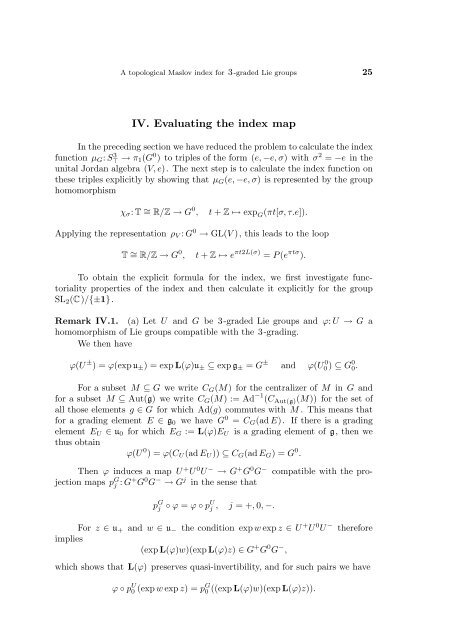A topological Maslov index for 3-graded Lie groups - ResearchGate
A topological Maslov index for 3-graded Lie groups - ResearchGate
A topological Maslov index for 3-graded Lie groups - ResearchGate
You also want an ePaper? Increase the reach of your titles
YUMPU automatically turns print PDFs into web optimized ePapers that Google loves.
A <strong>topological</strong> <strong>Maslov</strong> <strong>index</strong> <strong>for</strong> 3-<strong>graded</strong> <strong>Lie</strong> <strong>groups</strong> 25<br />
IV. Evaluating the <strong>index</strong> map<br />
In the preceding section we have reduced the problem to calculate the <strong>index</strong><br />
function µG: S 3 ⊤ → π1(G 0 ) to triples of the <strong>for</strong>m (e, −e, σ) with σ 2 = −e in the<br />
unital Jordan algebra (V, e). The next step is to calculate the <strong>index</strong> function on<br />
these triples explicitly by showing that µG(e, −e, σ) is represented by the group<br />
homomorphism<br />
χσ: T ∼ = R/Z → G 0 , t + Z ↦→ exp G(πt[σ, τ.e]).<br />
Applying the representation ρV : G 0 → GL(V ), this leads to the loop<br />
T ∼ = R/Z → G 0 , t + Z ↦→ e πt2L(σ) = P(e πtσ ).<br />
To obtain the explicit <strong>for</strong>mula <strong>for</strong> the <strong>index</strong>, we first investigate functoriality<br />
properties of the <strong>index</strong> and then calculate it explicitly <strong>for</strong> the group<br />
SL2(C)/{±1}.<br />
Remark IV.1. (a) Let U and G be 3-<strong>graded</strong> <strong>Lie</strong> <strong>groups</strong> and ϕ: U → G a<br />
homomorphism of <strong>Lie</strong> <strong>groups</strong> compatible with the 3-grading.<br />
We then have<br />
ϕ(U ± ) = ϕ(exp u±) = expL(ϕ)u± ⊆ exp g± = G ±<br />
and ϕ(U 0 0) ⊆ G 0 0.<br />
For a subset M ⊆ G we write CG(M) <strong>for</strong> the centralizer of M in G and<br />
<strong>for</strong> a subset M ⊆ Aut(g) we write CG(M) := Ad −1 (C Aut(g)(M)) <strong>for</strong> the set of<br />
all those elements g ∈ G <strong>for</strong> which Ad(g) commutes with M . This means that<br />
<strong>for</strong> a grading element E ∈ g0 we have G 0 = CG(ad E). If there is a grading<br />
element EU ∈ u0 <strong>for</strong> which EG := L(ϕ)EU is a grading element of g, then we<br />
thus obtain<br />
ϕ(U 0 ) = ϕ(CU(ad EU)) ⊆ CG(ad EG) = G 0 .<br />
Then ϕ induces a map U + U 0 U − → G + G 0 G − compatible with the projection<br />
maps p G j : G+ G 0 G − → G j in the sense that<br />
p G j ◦ ϕ = ϕ ◦ pU j<br />
, j = +, 0, −.<br />
For z ∈ u+ and w ∈ u− the condition expw exp z ∈ U + U 0 U − there<strong>for</strong>e<br />
implies<br />
(expL(ϕ)w)(expL(ϕ)z) ∈ G + G 0 G − ,<br />
which shows that L(ϕ) preserves quasi-invertibility, and <strong>for</strong> such pairs we have<br />
ϕ ◦ p U 0 (exp w exp z) = pG 0 ((expL(ϕ)w)(expL(ϕ)z)).

















